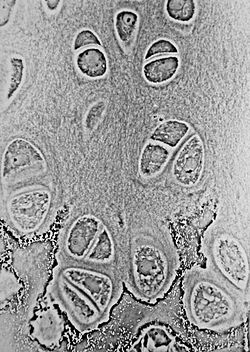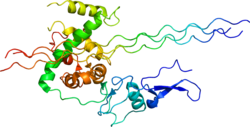Collagens
Collagen is the polymer that makes up the extracellular matrix in animal cells. It plays the role of binding tissue in animal cells. It is the most important component of the extracellular matrix, and it is also the main structural protein of animal structural tissues. Collagen exists mainly in the form of insoluble fibrin. In the composition of the human body, it accounts for about 33% of protein, and plays the role of 'mattress' and 'cement', which can ensure and connect various tissues to support the structure of the human body. The reason why the skin is full of elasticity is mainly because the collagen in the dermis layer of the skin forms the skin scaffold. Along with human aging, busy work and fatigue, the reduction of skin collagen secretion makes the delicate skin become loose and dry, and wrinkles and luster appear. Therefore, to maintain the youthful vitality of the skin, it is necessary to increase the skin collagen content.
 Figure 1. Structure of collagen.
Figure 1. Structure of collagen.
Classification
From the perspective of types, there are more than 20 types of collagen in the human body so far. Different types of collagen have different molecular structures and immunological characteristics. They can be classified into three types according to tissue classification:
Type I: Interstitial collagen type I-III, which is mainly present in the skin and tendons and other tissues, is the collagen between cells and has a strong tensile strength. Type II collagen is produced by chondrocytes.
Type Ⅱ : Basement membrane collagen has IV-Ⅶ type gland as basement membrane collagen, which mainly exists in organs.
 Figure 2. Type Ⅱ collagen.
Figure 2. Type Ⅱ collagen.
Type III: Cartilage collagen has Ⅸ-Ⅺ type, which is a trace amount of collagen in cartilage and cartilage formation.
From the structural point of view, the molecular structure of collagen is unique. The three molecules have a helical structure and polymorphism. The amino acid composition of the collagen peptide chain is unique. The glycine content is one-third. Each of these amino acids accounts for 10%. Among them, hydroxyproline is only found in collagen in animal tissues, and the collagen conversion rate in skin is generally slow. Children's skin is mainly type III, and adult skin is mainly type I. With As the age increases, the number of cross-linked tendons increases, and the more closely the collagen fibers are related to the skin's aging and stiffness, so the skin appears loose.
From the biological effects of collagen, collagen has the highest content in the extracellular matrix (skin), the highest rigidity and tensile strength, and it is the skeleton structure in the extracellular matrix. In addition, other components in the extracellular matrix can be related to collagen. The combination constitutes a unity of structure and function, and at the same time, various types of collagen have certain selectivity when combined with extracellular matrix components.
 Figure 3. Type III collagen.
Figure 3. Type III collagen.
Disease
1,000 mutations have been identified in 12 of the more than 20 collagens. These mutations can cause various diseases at the tissue level.
Osteogenesis imperfecta-Caused by a type 1 collagen mutation, a dominant autosomal disease, resulting in weak bones and irregular connective tissue. Some conditions may be mild while others may be fatal. Type 1 collagen levels were reduced in mild cases, while collagen structural defects were found in severe cases.
Cartilage dysplasia-Bone disease is thought to be caused by a type 2 collagen mutation, and further research is currently underway to confirm this.
Ehlers-Danlos syndrome-Thirteen different types of diseases that cause deformities of connective tissue. Some rare types can be fatal and cause arteries to rupture. Each syndrome is caused by a different mutation. For example, the vascular type (vEDS) of this disease is caused by mutations in type 3 collagen.
Alport syndrome-can be transmitted genetically, usually X-linked dominant, or autosomal dominant and autosomal recessive, with kidney and eye problems, and hearing in children or adolescents obstacle.
Applications
Collagen is the main component of human tissues. It has an inseparable relationship with human organs and cells, so it is used for repair and regeneration of human organs and tissues. Related medical applications of collagen include collagen sponges, silk glands, films (surgical hemostasis, used for cardiac blood vessels, nerves, oral cavity, orthopedics, skin, gynecological surgery, etc.) wound dressings, artificial skin, blood vessels, heart valves, corneas Protective materials, injection collagen (for wrinkle removal, soft tissue filling and filling, treatment of urinary incontinence, urine reflux, orthopedic tissue regeneration filler), drug auxiliary mechanism, collagen matrix template and other uses. Generally speaking, the basic unit of protein is amino acids, while its collagen is one of the main ingredients for maintaining firmness and elasticity.
Reference:
- Di Lullo, et al.; Mapping the Ligand-binding Sites and Disease-associated Mutations on the Most Abundant Protein in the Human, Type I Collagen. J. Biol. Chem. 2002, 277 (6): 4223–4231.


